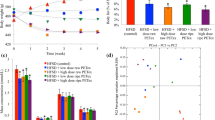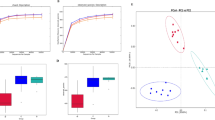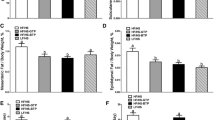Abstract
The use of Bacillus circulans as the sole starter provides better process control compared to natural fermentation. However, the chemical composition of fermented Tibetan tea by B. circulans and its regulatory effects on the intestine–liver axis has not been reported. For this purpose, a high-resolution liquid chromatography tandem mass spectrometry metabolomics approach was performed. The effects of fermented Tibetan tea on the intestine–liver axis of mice were also evaluated. Untargeted metabolomics analysis showed that the contents of catechin derivatives, flavonoids, phenolic acids, and terpenoids increased by 0.3, 2.38, 2.65, and 3.36%, respectively, compared with those before fermentation. Furthermore, 16S ribosomal RNA sequence analysis revealed that the relative abundance of Lactobacillus spp. in the intestine increased after consumption of fermented tea. Additionally, based on histological and quantitative PCR analyses, fermented Tibetan tea also improved intestinal development and intestinal barrier function in mouse, while increasing the antioxidant capacity of mouse liver. Thus, fermented Tibetan tea could provide beneficial health effects through the intestine–liver axis. These findings have facilitated the study of the chemical composition of Tibetan tea and provided theoretical support for its use as a natural beverage with intestinal probiotic functions.








Similar content being viewed by others
Data Availability
The raw sequence data reported in this paper have been deposited in the Genome Sequence Archive (Genomics, Proteomics & Bioinformatics 2017) in National Genomics Data Center (Nucleic Acids Res 2021), China National Center for Bioinformation/Beijing Institute of Genomics, Chinese Academy of Sciences, under accession number CRA008557 that are publicly accessible at https://bigd.big.ac.cn/gsa.
References
Zheng PC, Qin CY, Liu PP, Feng L, Ling TJ, Ning JM, Zhang L, Wan XC (2021) Untargeted metabolomics combined with bioassay reveals the change in critical bioactive compounds during the processing of Qingzhuan tea. Molecules 26(21):6718. https://doi.org/10.3390/molecules26216718
Cheng L, Wang Y, Zhang J, Zhu J, Liu P, Xu L, Wei K, Zhou H, Peng L, Zhang J, Wei X, Liu Z (2021) Dynamic changes of metabolic profile and taste quality during the long-term aging of Qingzhuan Tea: the impact of storage age. Food Chem 359:129953. https://doi.org/10.1016/j.foodchem.2021.129953
Zhu MZ, Li N, Zhou F, Ouyang J, Lu DM, Xu W, Li J, Lin HY, Zhang Z, Xiao JB, Wang KB, Huang JA, Liu ZH, Wu JL (2020) Microbial bioconversion of the chemical components in dark tea. Food Chem 312:126043. https://doi.org/10.1016/j.foodchem.2019.126043
Zhang L, Zhang ZZ, Zhou YB, Ling TJ, Wan XC (2013) Chinese dark teas: postfermentation, chemistry and biological activities. Int Food Res J 53(2):600–607. https://doi.org/10.1016/j.foodres.2013.01.016
Fischer C, Kleinschmidt T (2018) Synthesis of galactooligosaccharides in milk and whey: a review. Compr Rev Food Sci Food Saf 17(3):678–697. https://doi.org/10.1111/1541-4337.12344
Suyotha W, Yano S, Wakayama M (2016) α-1,3-Glucanase: present situation and prospect of research. World J Microbiol Biotechnol 32(2):30. https://doi.org/10.1007/s11274-015-1977-0
Liu Y, Huang W, Zhang C, Li C, Fang Z, Zeng Z, Hu B, Chen H, Wu W, Wang T, Lan X (2022) Targeted and untargeted metabolomic analyses and biological activity of Tibetan tea. Food Chem 384:132517. https://doi.org/10.1016/j.foodchem.2022.132517
Xie H, Li X, Ren Z, Qiu W, Chen J, Jiang Q, Chen B, Chen D (2018) Antioxidant and cytoprotective effects of Tibetan tea and its phenolic components. Molecules 23(2):179. https://doi.org/10.3390/molecules23020179
Wang N, Wu T, Du D, Mei J, Luo H, Liu Z, Saleemi MK, Zhang R, Chang C, Mehmood MA, Zhu H (2022) Transcriptome and gut microbiota profiling revealed the protective effect of Tibetan tea on ulcerative colitis in mice. Front Microbiol 12:748594. https://doi.org/10.3389/fmicb.2021.748594
Konturek PC, Harsch IA, Konturek K, Schink M, Konturek T, Neurath MF, Zopf Y (2018) Gut-liver axis: how do gut bacteria influence the liver? Med Sci (Basel) 6(3):79. https://doi.org/10.3390/medsci6030079
Jiang Z, Zhuo LB, He Y, Fu Y, Shen L, Xu F, Gou W, Miao Z, Shuai M, Liang Y, Xiao C, Liang X, Tian Y, Wang J, Tang J, Deng K, Zhou H, Chen YM, Zheng JS (2022) The gut microbiota-bile acid axis links the positive association between chronic insomnia and cardiometabolic diseases. Nat Commun 13(1):3002. https://doi.org/10.1038/s41467-022-30712-x
Chen T, Li R, Chen P (2021) Gut microbiota and chemical-induced acute liver injury. Front Physiol 12:688780. https://doi.org/10.3389/fphys.2021.688780
Tripathi A, Debelius J, Brenner DA, Karin M, Loomba R, Schnabl B, Knight R (2018) The gut-liver axis and the intersection with the microbiome. Nat Rev Gastroenterol Hepatol 15(7):397–411. https://doi.org/10.1038/s41575-018-0011-z
Li J, Chen C, Yang H, Yang X (2021) Tea polyphenols regulate gut microbiota dysbiosis induced by antibiotic in mice. Food Res Int 141:110153. https://doi.org/10.1016/j.foodres.2021.110153
Li W, Liu Y, Ye Y, Che Z, Wu T (2021) Chemical profiling and metabolic mechanism of Pixian doubanjiang, a famous condiment in Chinese cuisine. LWT 145:111274. https://doi.org/10.1016/j.lwt.2021.111274
Li Q, Chai S, Li Y, Huang J, Luo Y, Xiao L, Liu Z (2018) Biochemical components associated with microbial community shift during the pile-fermentation of primary dark tea. Front Microbiol 9:1509. https://doi.org/10.3389/fmicb.2018.01509
Xiao Y, Li M, Liu Y, Xu S, Zhong K, Wu Y, Gao H (2021) The effect of Eurotium cristatum (MF800948) fermentation on the quality of autumn green tea. Food Chem 358:129848. https://doi.org/10.1016/j.foodchem.2021.129848
Deng X, Hou Y, Zhou H, Li Y, Xue Z, Xue X, Huang G, Huang K, He X, Xu W (2021) Hypolipidemic, anti-inflammatory, and anti-atherosclerotic effects of tea before and after microbial fermentation. Food Sci Nutr 9(2):1160–1170. https://doi.org/10.1002/fsn3.2096
Bond T, Derbyshire E (2019) Tea compounds and the gut microbiome: findings from trials and mechanistic studies. Nutrients 11(10):2364. https://doi.org/10.3390/nu11102364
Liu JY, He D, Xing YF, Zeng W, Ren K, Zhang C, Lu Y, Yang S, Ou SJ, Wang Y, Xing XH (2021) Effects of bioactive components of Pu-erh tea on gut microbiomes and health: a review. Food Chem 353:129439. https://doi.org/10.1016/j.foodchem.2021.129439
Heeney DD, Gareau MG, Marco ML (2018) Intestinal Lactobacillus in health and disease, a driver or just along for the ride? Curr Opin Biotechnol 49:140–147. https://doi.org/10.1016/j.copbio.2017.08.004
Wells JM, Brummer RJ, Derrien M, MacDonald TT, Troost F, Cani PD, Theodorou V, Dekker J, Méheust A, de Vos WM, Mercenier A, Nauta A, Garcia-Rodenas CL (2017) Homeostasis of the gut barrier and potential biomarkers. Am J Physiol Gastrointest Liver Physiol 312(3):G171–G193. https://doi.org/10.1152/ajpgi.00048.2015
Bienenstock J, Gibson G, Klaenhammer TR, Walker A, Neish AS (2013) New insights into probiotic mechanisms: a harvest from functional and metagenomic studies. Gut Microbes 4(2):94–100. https://doi.org/10.4161/gmic.23283
Dempsey E, Corr SC (2022) Lactobacillus spp. for gastrointestinal health: current and future perspectives. Front Immunol 13:840245. https://doi.org/10.3389/fimmu.2022.840245
Qi H, Li Y, Yun H, Zhang T, Huang Y, Zhou J, Yan H, Wei J, Liu Y, Zhang Z, Gao Y, Che Y, Su X, Zhu D, Zhang Y, Zhong J, Yang R (2019) Lactobacillus maintains healthy gut mucosa by producing L-Ornithine. Commun Biol 2:171. https://doi.org/10.1038/s42003-019-0424-4
Wang T, Teng K, Liu G, Liu Y, Zhang J, Zhang X, Zhang M, Tao Y, Zhong J (2018) Lactobacillus reuteri HCM2 protects mice against Enterotoxigenic Escherichia coli through modulation of gut microbiota. Sci Rep 8(1):17485. https://doi.org/10.1038/s41598-018-35702-y
Yu Z, Li Y, Niu Y, Tang Q, Wu J (2021) Milk fat globule membrane enhances colonic-mucus-barrier function in a rat model of short-bowel syndrome. JPEN J Parenter Enteral Nutr 45(5):916–925. https://doi.org/10.1002/jpen.1956
Lai HH, Chiu CH, Kong MS, Chang CJ, Chen CC (2019) Probiotic Lactobacillus casei: effective for managing childhood diarrhea by altering gut microbiota and attenuating fecal inflammatory markers. Nutrients 11(5):1150. https://doi.org/10.3390/nu11051150
Oh NS, Lee JY, Kim YT, Kim SH, Lee JH (2020) Cancer-protective effect of a synbiotic combination between Lactobacillus gasseri 505 and a Cudrania tricuspidata leaf extract on colitis-associated colorectal cancer. Gut Microbes 12(1):1785803. https://doi.org/10.1080/19490976.2020.1785803
Lu F, Li Y, Wang X, Hu X, Liao X, Zhang Y (2021) Early-life polyphenol intake promotes Akkermansia growth and increase of host goblet cells in association with the potential synergistic effect of Lactobacillus. Food Res Int 149:110648. https://doi.org/10.1016/j.foodres.2021.110648
Cheng P, Wu J, Zong G, Wang F, Deng R, Tao R, Lu Y (2023) Capsaicin shapes gut microbiota and pre-metastatic niche to facilitate cancer metastasis to liver. Pharmacological Research 106643. https://doi.org/10.1016/j.phrs.2022.106643
Milosevic I, Vujovic A, Barac A, Djelic M, Korac M, Radovanovic Spurnic A, Gmizic I, Stevanovic O, Djordjevic V, Lekic N, Russo E, Amedei A (2019) Gut-liver axis, gut microbiota, and its modulation in the management of liver diseases: a review of the literature. Int J Mol Sci 20(2):395. https://doi.org/10.3390/ijms20020395
Zhao X, Zhong X, Liu X, Wang X, Gao X (2021) Therapeutic and improving function of lactobacilli in the prevention and treatment of cardiovascular-related diseases: a novel perspective from gut microbiota. Front Nutr 8, 693412. https://doi.org/10.3389/fnut.2021.693412
Wu Y, Sun H, Yi R, Tan F, Zhao X (2021) Anti-obesity effect of Liupao tea extract by modulating lipid metabolism and oxidative stress in high-fat-diet-induced obese mice. J Food Sci 86(1):215–227. https://doi.org/10.1111/1750-3841.15551
Rea IM, Gibson DS, McGilligan V, McNerlan SE, Alexander HD, Ross OA (2018) Age and age-related diseases: role of inflammation triggers and cytokines. Front Immunol 9:586. https://doi.org/10.3389/fimmu.2018.00586
Kim HG, Lee SY, Kim NR, Lee HY, Ko MY, Jung BJ, Kim CM, Lee JM, Park JH, Han SH, Chung DK (2011) Lactobacillus plantarum lipoteichoic acid down-regulated Shigella flexneri peptidoglycan-induced inflammation. Mol Immunol 48(4):382–391. https://doi.org/10.1016/j.molimm.2010.07.011
Funding
This work was funded by the Science and Technology Department of Sichuan Province, grant number 2020YFH0130; the Talent Introduction Project of Sichuan University of Science & Engineering, grant number 2019RC29; the Academician (Expert) Workstation Project of Sichuan University of Science &Engineering, grant number 2018YSCZZ01; and the Innovation and Entrepreneurship Program for College Students, grant numbers cx2021140, S202210622023, and cx2022132.
Author information
Authors and Affiliations
Contributions
Ning Wang, Hui Zhu, and Muhammad Aamer Mehmood conceived the study. Shan Mo designed the study and wrote the first version of the manuscript. Muhammad Aamer Mehmood participated in its design and coordination and performed the statistical analysis. Haiyan Sun, Yongqing Tang, and Jie Mei conceived of the study and collected the experimental material. Jie Mei, Yuan Mei, Wen Fang, and Hui Zhu collected and analyzed the raw data. Ning Wang and Tao Wu revised the manuscript. Hui Zhu was responsible for this study, participated in its design and coordination, and helped draft the manuscript. All authors have read and approved the final manuscript.
Corresponding author
Ethics declarations
Conflict of Interest
The authors declare no competing interests.
Additional information
Publisher's Note
Springer Nature remains neutral with regard to jurisdictional claims in published maps and institutional affiliations.
Supplementary Information
Below is the link to the electronic supplementary material.
Rights and permissions
Springer Nature or its licensor (e.g. a society or other partner) holds exclusive rights to this article under a publishing agreement with the author(s) or other rightsholder(s); author self-archiving of the accepted manuscript version of this article is solely governed by the terms of such publishing agreement and applicable law.
About this article
Cite this article
Wang, N., Mo, S., Wu, T. et al. Metabolomic Analysis of Fermented Tibetan Tea Using Bacillus circulans and Their Biological Activity on Mice via the Intestine–Hepatic Axis. Probiotics & Antimicro. Prot. 15, 1653–1664 (2023). https://doi.org/10.1007/s12602-023-10049-7
Accepted:
Published:
Issue Date:
DOI: https://doi.org/10.1007/s12602-023-10049-7




